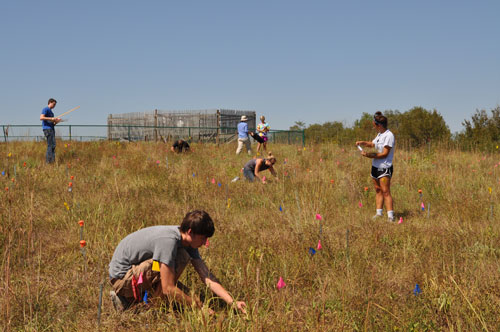For nearly half a century, ecologists have struggled to explain the relationship between ecosystem productivity and species richness. In a recent paper in Nature, USGS Ecologist James Grace and colleagues have managed to account for the many variables and confirm the long-suspected connection. To do so, they used a causal network model to incorporate data from more than 1000 grassland plots that are part of the Nutrient Network Cooperative.
The skirmishes between competing ideas have been plentiful: early models predicted that increasing productivity reduces species richness; a decade later, scientists asserted the opposite—that the two went hand in hand. Both interpretations were further muddied by theories suggesting that macroclimatic gradients drive the context in which richness and productivity interact.
None of these analyses have achieved the desired explanatory power. But if productivity and richness are jointly controlled by a nuanced network of processes, as Grace et al. propose, then the traditional bivariate model with its singular cause and effect pathway has no hope of accurately describing these relationships.

Different Statistical Approach Allows Greater Nuance
Grace and his colleagues took a different approach, using structural equation modeling (SEM) to describe this network of causal relations—a task impossible within the rigid architecture of conventional statistics. Rather than adopt just one of the competing theories, they identified all the main theoretical constructs articulated in the literature and then hypothesized ways to interconnect them—building a metamodel to explain the observed feedbacks between productivity, species diversity, and other related factors.
Next, they built a structural equation model to describe the linkages depicted by their metamodel. The number and diversity of sites available through the Nutrient Network allowed them to evaluate and test the validity of their multiple overlapping hypotheses and search for missing linkages. They looked for opportunities to eliminate extraneous parameters, but lower-dimension models were not able to isolate underlying processes and predict real-world observations as effectively.
Richness-Productivity Relationship Stronger than Expected
The resulting model successfully integrates much of the preceding research, while also generating several new and surprising results. The researchers highlighted three key takeaways: first, the model validates that species richness increases productivity (r = 0.67), and surprisingly, this effect does not appear to level off even at high levels of richness.
Second, accumulation of above-ground biomass (alive and dead) decreases species richness (r = -0.77), most likely a result of competition for resources, particularly light. However, the model contests assumptions that this competition intensifies with increasing productivity, instead revealing it as a consistent influence across productivity values. And lastly, macroclimate and soils play significant and independent influences on richness and productivity; for instance, productivity was influenced most by soil fertility, while richness was most closely correlated to climate and soil suitability.
Grace et al’s causal network explains 61 percent of the variation in richness among sites and 65 percent among plots—a notable contrast to the bivariate model, which the team asserts cannot explain more than about 10 percent. In Kevin Gross’ Nature response to the paper, he cautions that just because one causal network is consistent with the data does not preclude others from being consistent as well. Fair enough.
But the Nature article demonstrates that integrative modeling can allow ecologists to more effectively investigate and–at least potentially–predict the complex stew of impacts that human intervention and climatic change have on ecosystems.










